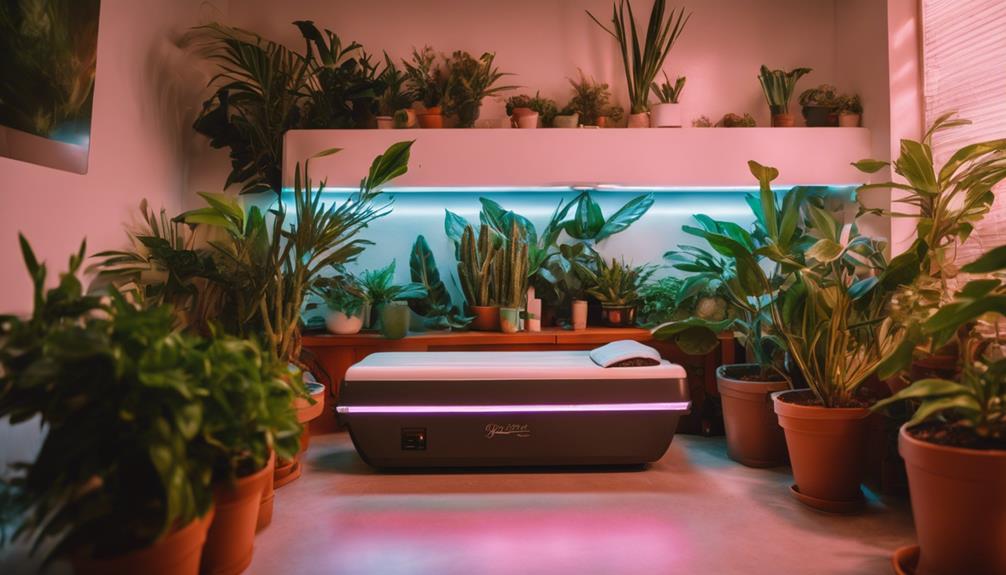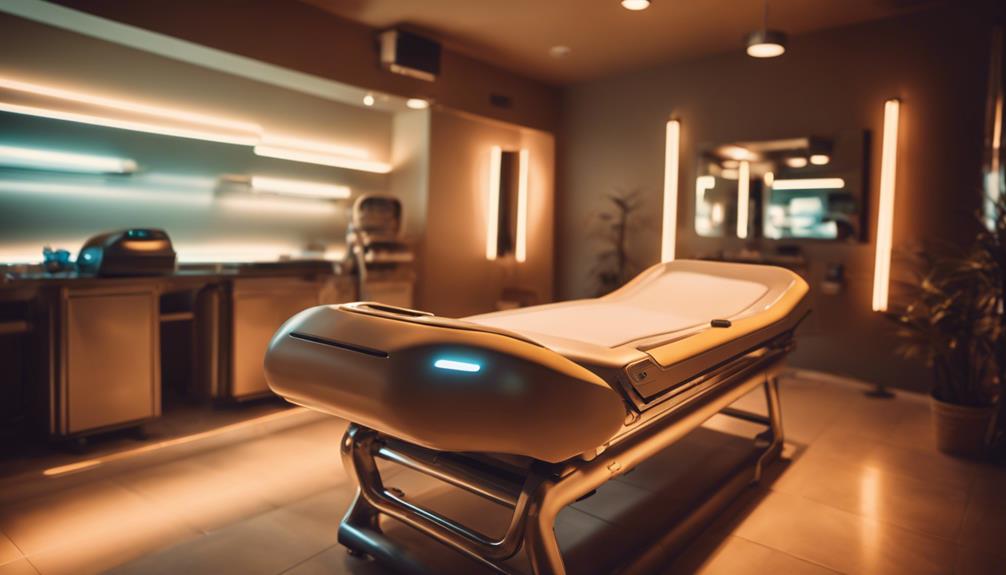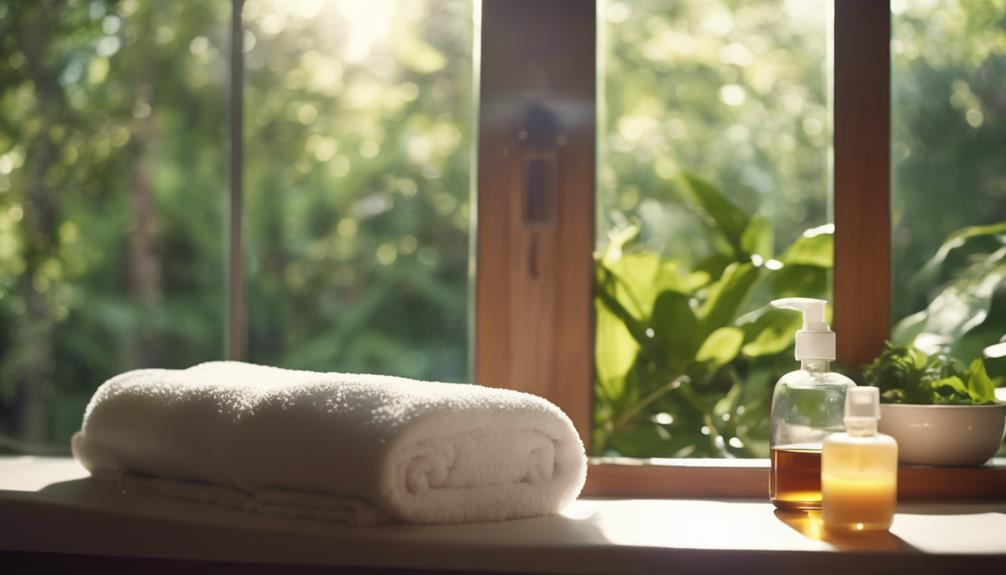Tanning beds expose you to concentrated UVA and UVB rays, greatly elevating your risk of skin damage and cancer compared to natural sunlight. These rays lead to premature aging and increase the likelihood of skin issues, particularly if you have fair skin or many moles. Without proper eye protection, you can also harm your eyes. It's essential to limit your tanning sessions and always check your skin for changes. Understanding these risks can help you make safer choices. If you're curious about how to protect yourself better, there's more to uncover about managing tanning bed use effectively.
Key Takeaways
- Tanning beds emit concentrated UVA and UVB rays, significantly increasing the risk of skin damage and skin cancer compared to natural sunlight.
- Intense UV exposure accelerates skin aging, leading to premature wrinkles and other long-term skin issues.
- Fair-skinned individuals or those with many moles are at a heightened risk for severe skin damage and cancer from tanning bed use.
- Lack of proper eye protection during tanning sessions can result in long-term eye damage, including cataracts.
Understanding UV Rays
Understanding UV rays is essential for recognizing the potential dangers associated with tanning beds and protecting your skin effectively.
Tanning beds emit UVA and UVB rays, similar to natural sunlight, with UVA rays making up about 94% of UV radiation on Earth.
You should know that UVA radiation mainly causes long-term skin damage and aging, while UVB radiation leads to immediate reactions like sunburn and contributes to skin cancer risk.
Tanning beds deliver concentrated doses of these rays, increasing your risk compared to natural sun exposure.
Since UVC radiation is mostly filtered out, it poses minimal risk.
Staying informed about the different types of UV rays can help you make safer decisions regarding tanning bed use and sun safety practices.
Health Risks of Tanning Beds

Tanning beds pose important health risks, primarily due to their intense exposure to UVA and UVB rays, which can lead to serious skin damage and increase the likelihood of developing skin cancer.
When you use a tanning bed, you expose your skin to concentrated doses of UV radiation, far more than you'd receive from natural sunlight. This can accelerate skin aging, causing premature wrinkles and leathery texture. If you have fair skin or numerous moles, your risk is even higher.
Additionally, without proper eye protection, you may suffer from long-term eye damage. Understanding these risks is essential for making informed decisions about tanning bed use and prioritizing your skin's health.
Avoiding tanning beds can greatly lower your risk.
Tanning Bed Safety Measures

How can you guarantee your safety while using a tanning bed?
First, always wear protective eyewear to shield your eyes from harmful UV rays.
Limit your sessions to reduce the risk of skin damage; even a few minutes can be effective.
Make sure you're over 18, as tanning beds are prohibited for younger users.
Before tanning, check your skin for any unusual spots or changes, and consider scheduling regular skin checks with a dermatologist.
Hydrate your skin with appropriate lotions before and after your session.
Recommended Tanning Practices

After ensuring your safety with protective measures, it's important to adopt recommended tanning practices that minimize risks while achieving your desired glow. Here are some tips to follow:
- Limit Session Duration: Keep your tanning sessions short, especially if you're new to tanning beds. Start with 5-10 minutes to gauge your skin's response.
- Choose a Schedule: Space out your sessions to allow your skin time to recover. Aiming for 1-2 sessions per week is often ideal.
- Stay Hydrated: Drink plenty of water before and after your tanning sessions. Hydrated skin tans better and is less prone to damage.
Choosing the Right Products

Selecting the right products can greatly enhance your tanning experience while protecting your skin from potential damage.
You'll want to choose bronzer lotions that suit your skin type—whether it's dry, oily, or sensitive. Look for hydrating ingredients to keep your skin moisturized during and after tanning.
Don't forget to opt for bronzer lotions with SPF protection to shield your skin from harmful UV rays. Natural or organic components can also help minimize irritation, giving you a healthier glow.
Always read labels and avoid products with harsh chemicals. Investing in quality tanning products not only promotes a radiant complexion but also supports your skin's health in the long run.
Make informed choices to maximize both safety and results.
Signs of Skin Damage

Recognizing the signs of skin damage is essential, especially after using tanning products that may not fully protect your skin from harmful UV exposure. Being aware of these signs can help you take action early and prevent further harm.
Here are three common signs of skin damage to watch for:
- Redness or Inflammation: A sign of sunburn or irritation from UV exposure.
- Peeling or Flaking Skin: Indicates that your skin is shedding dead cells due to damage.
- New or Changing Moles: Any changes in size, shape, or color should be examined by a dermatologist.
If you notice any of these signs, it's vital to adjust your tanning habits and consult a professional for advice. Your skin's health matters!
Myths About Tanning Beds

Many people believe that tanning beds are a safe alternative to sunbathing, but this common myth can lead to serious health risks.
You might think that indoor tanning is less harmful because it's controlled, but the reality is that tanning beds emit concentrated UVA and UVB rays, increasing your risk of skin cancer greatly.
Another misconception is that tanning beds can provide a “base tan” to prevent sunburn; however, this false sense of security can lead to prolonged sun exposure.
Additionally, some believe that tanning beds are safe for all skin types, but fair-skinned individuals are particularly vulnerable.
It's essential to understand these myths and make informed choices to protect your skin and overall health.
Frequently Asked Questions
Can Tanning Beds Help With Vitamin D Deficiency?
Tanning beds can produce vitamin D, but they expose you to harmful UV rays. It's safer to get vitamin D from sunlight, supplements, or fortified foods instead of relying on tanning beds for your health.
How Long Does a Tanning Session Typically Last?
A tanning session typically lasts between 5 to 15 minutes, depending on your skin type and the bed's intensity. Always start with shorter sessions to see how your skin reacts before increasing the duration.
Are There Any Safe Alternatives to Tanning Beds?
Yes, there are safe alternatives to tanning beds. You can use self-tanners or bronzing lotions, which provide a sun-kissed glow without UV exposure. Additionally, consider spray tans for an even, natural-looking tan without the risks.
What Should I Do if I Get Sunburned From Tanning?
If you've turned into a lobster from tanning, soothe your skin with cool compresses, aloe vera, and plenty of hydration. Avoid further sun exposure, and give your skin time to heal before trying again.
How Often Can I Safely Use a Tanning Bed?
You can safely use a tanning bed about once a week, but it's essential to monitor your skin's response. Limiting sessions helps reduce risks while still achieving a desired tan without excessive UV exposure.
Conclusion
As you weigh the allure of a bronzed glow against the lurking dangers, remember that your skin is your canvas. Protect it like a precious work of art.
By understanding the risks and following safety measures, you can enjoy a sun-kissed look without sacrificing your health. Stay informed, choose wisely, and embrace alternatives that keep your skin safe while still shining bright.
Your health should always take center stage in the pursuit of beauty.










